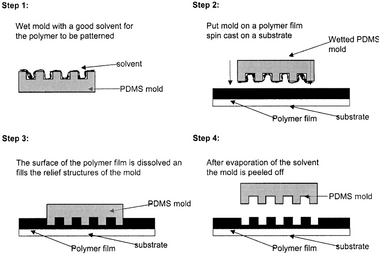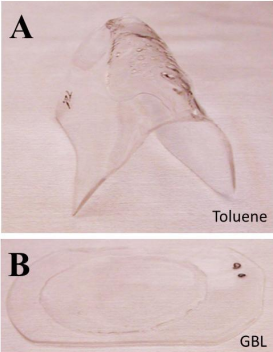Solvent Assisted Micromolding (SAMIM) - Stanley Chen
Background: Solvent-Assisted Micromolding (SAMIM)

Solvent-Assisted Micromolding (SAMIM) is a type of soft lithography which combines techniques utilized in Replica Molding (REM) and embossing to fabricate high-quality micro- and nanostructures and modify surface morphologies using an elastomeric mold (master), commonly made from polydimethylsiloxane (PDMS). The surface of these soft elastomeric molds are wetted with solvent and placed onto a thin polymeric substrate. The solvent then dissolves or softens the polymer film, causing it to conform to the shape of the elastomeric mold. As the solvent evaporates, the film will once again solidify and the mold can be removed, leaving behind a hardened polymer film in the shape of the mold's surface [1][2]. The procedure is shown in Figure 1.
Motivation
Nanofabrication is a technique used to pattern and shape functional devices on a nanoscale (minimum dimensions ≥ 100 nm) commonly used for electronics and information technology. Traditional methods for nanofabrication are "top-down" methods such as scanning beam lithography and projection lithography. These methods are commercially available but its use is limited by its installation and maintenance costs. The current techniques available are highly optimized for the semiconductor fabrication which limits its utilization in other practices. Soft lithography techniques like SAMIM relieve these restrictions because it offers the ability to use organic and reactive materials and create more complex 3-D structures.
SAMIM is a very important technique used in nanofabrication in order to pattern and shape functional devices on the nano-scale because of its advantages over traditional, "top-down", methods of creating nanostructures.SAMIM differs from traditional "top-down" methods because it offers an inexpensive method for mass producing products with nonplanar surface morphology due to its soft PDMS mold. The major disadvantages of SAMIM is the swelling which occurs that distorts the pattern of the surface and the lack of available master materials which is limits the size reduction of topography [3][4].
Challenges Facing SAMIM

Pattern transfer precision
The precision of transferring the master pattern is limited by the materials and the molecular size of the materials used. PDMS is a common material used with SAMIM but is limited by solvent transport through it and it leaves residue behind isolated features upon molding. Solvent transport may cause swelling of the PDMS which distorts the topographical features. PS, PMMA, cellulose acetate, and poly(vinylchloride) (PVC) have demonstrated to work with SAMIM over non-planar areas > 1cm2 but the lack of masters for SAMIM have limited the line widths of patterning to ~60nm with novolac photoresists and PVC. PDMS still remains a competitive option because it has been shown to be able to create features as small as ~20 nm with PDMS. The swelling properties of PDMS can also be controlled with increased understanding of solvent-polymer interactions [3][5].
The size and shape of the molecules used to create the molded material determine the resolution of the pattern transfer. Although there is no physics-based limitations to molding, the molecules that make up the polymer and the molecules that make up the mold have a granularity of matter which limits the resolution(0.1 - 1 nm) on a chemical level. Intermolecular forces also create separation between a mold and a master,which is predicted by van der Waals interactions as a separation of ~0.1 nm. To work around this resolution limitation, smaller molecules such as monomers, prepolymers, and amorphous materials are being investigated for its molding capabilities [3][5].
Distortion of Features at the Nanoscale
The elastomeric molds used for SAMIM have a low elastic modulus so they can easily be distorted by swelling caused by evaporation of the solvent. The flexibility of the elastomeric molds make it suspectible to distortion because of the mechanical instability. Adhesion between the master and mold can also cause changes to the pattern topography. The swelling is shown in Figure 2 [3][5].
Current Applications
Prototyping
Soft lithography offers the ability to quickly prototype new nanostructures without the need for expensive and specialized materials since you can create many molds and replicas from one master. It can prototype on a nanoscale over a large area (≤ 20 cm2) and also scale up to a microscale (10 to 100 μm)[4].
3D Structure fabrication
SAMIM has been shown to have the ability to create 3-D structures with a soft polymeric mold and solvent. Solvents were shown to absorb onto the molds effectively and fidelity of the structures were kept intact. SAMIM offered a highly efficient method to create 3-D structures with large areas [4]. SAMIM can also be integrated into existing 3-D structure fabrication techniques to take advantage of the high efficiency of SAMIM [7].
Polyelectrolyte Multilayers
Polyelectrolyte Multilayers (PEMS) are commonly created by methods such as surface selective deposition, inkjet printing, multiplayer transfer printing, and microcontact printing. These methods create PEMS by chemical bonding and covalent linking of PEM surfaces due to surface properties. Due to the difference in properties in PEMS, there is no universal method to create PEMS. SAMIM offers a method to create physical heterogeneous multilayer films through compression of the surface [7].
References
1. Brehmer, M.; Conrad, L.; Funk L. New Developments in Soft Lithography. Journal of Dispersion Science and Technology. 2003, 24, pp 291-304. http://dx.doi.org/10.1081 /DIS-120021792
2. Kim, E.; Xia, Y.; Zhao M,; Whitesides G. Solvent-Assisted Microcontact Molding: A Convenient Method for Fabricating Three-Dimensional Structures on Surfaces of Polymers. Advanced Materials. 1997, 9 No. 8. pp 651-654. http://dx.doi.org/10.1002/adma.19970090814
3. Gates, B.; Xu Q.; Stewart M.; Ryan D.; Wilson C.; Whitesides G. New Approaches to Nanofabrication: Molding, Printing, and Other Techniques. Chemical Reviews. 2005, 105, pp 1171-1196. http://dx.doi.org/10.1021/cr030076o
4. Gates B.; Xu Q.; Love C.; Wolf D.; Whitesides G. Unconventional Nanofabrication. Reviews in Advance. 2004, 16, pp 339-372. http://dx.doi.org/10.1146/annurev.matsci.34.052803.091100
5. D. Lipomi,;l Martinez R.; Whitesides G. Soft Lithographic Approaches to Nanofabrication. Poylmer Science: A Comprehensive Reference, 2012. Vol 7, pp 211-228. http://dx.doi.org/10.1016/B978-0-444-53349-4.00180-1
6. N.-N. Deng, Z.-J. Meng, R. Xie, X.-J. Ju, C.-L. Mou, W. Wang, and L.-Y. Chu, “Simple and cheap microfluidic devices for the preparation of monodisperse emulsions,” Lab on a Chip, vol. 11, No. 23, pp. 3963-3969, 2011. http://dx.doi.org/10.1039/C1LC20629J
7. L. Han, J. Zhou, X. Gong, and C. Gao, “Solvent-assisted polymer micro-molding,” Chinese Science Bulletin, vol. 54, no. 13, pp. 2193–2204, 2009.
